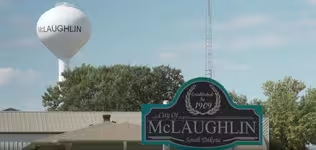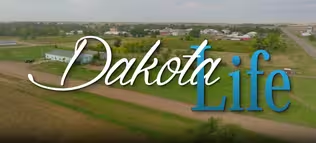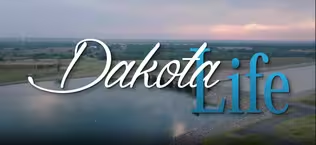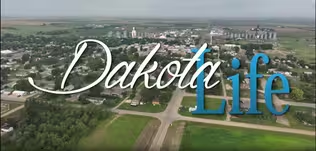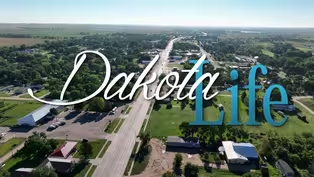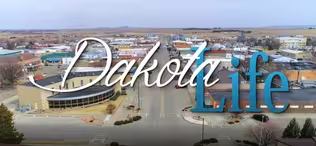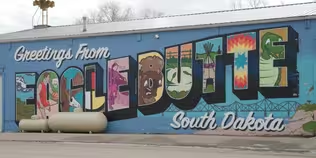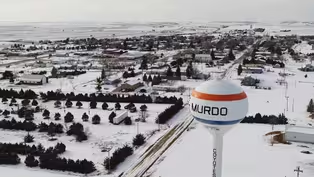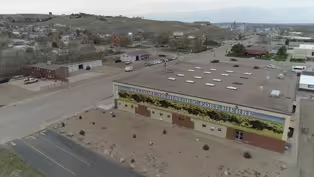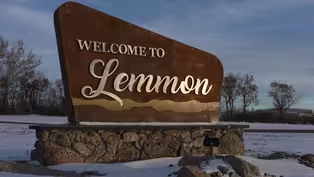Dakota Life
Greetings from Miller
Season 25 Episode 6 | 29m 22sVideo has Closed Captions
Greetings from Miller
We visit the nostalgic Midway Drive Inn theatre, join in on the fun at the annual South Hand Old Settler's Picnic, tour the county courthouse, and meet the people that maintain and decorate for the seasons. Plus, we learn why young people are moving back to Miller and how the community is committed to making Miller a great place to live..
Problems playing video? | Closed Captioning Feedback
Problems playing video? | Closed Captioning Feedback
Dakota Life is a local public television program presented by SDPB
Support Dakota Life with a gift to the Friends of Public Broadcasting
Dakota Life
Greetings from Miller
Season 25 Episode 6 | 29m 22sVideo has Closed Captions
We visit the nostalgic Midway Drive Inn theatre, join in on the fun at the annual South Hand Old Settler's Picnic, tour the county courthouse, and meet the people that maintain and decorate for the seasons. Plus, we learn why young people are moving back to Miller and how the community is committed to making Miller a great place to live..
Problems playing video? | Closed Captioning Feedback
How to Watch Dakota Life
Dakota Life is available to stream on pbs.org and the free PBS App, available on iPhone, Apple TV, Android TV, Android smartphones, Amazon Fire TV, Amazon Fire Tablet, Roku, Samsung Smart TV, and Vizio.
Providing Support for PBS.org
Learn Moreabout PBS online sponsorshipMore from This Collection
Video has Closed Captions
In the heart of the Standing Rock Indian Reservation, we discover McLaughlin. (29m 29s)
Video has Closed Captions
We travel to Burke and introduce you to a writer, an artist, and the twins of Franklin Street. (29m 50s)
Video has Closed Captions
Timber Lake celebrates its heritage in July with the Days of 1910 activities. (29m 41s)
Video has Closed Captions
Uplifting culture of the Dakota Oyate on the Crow Creek Reservation. (29m 17s)
Video has Closed Captions
Onida is home to a ranching family, a salmon fisherman, and a memorabilia collection. (27m 18s)
Video has Closed Captions
Dakota Life travels to the community of Mission. (29m 34s)
Video has Closed Captions
Winner has great baseball, theatre, and local authors and is a sportsperson's paradise. (27m 25s)
Video has Closed Captions
Dakota Life visits the community of Eagle Butte (26m 58s)
Video has Closed Captions
Fort Pierre is our host community this month for Dakota Life. (28m 36s)
Providing Support for PBS.org
Learn Moreabout PBS online sponsorship(soft music) - This is a production of South Dakota Public Broadcasting - Artifacts and archeological sites in what is present day.
Hand county, including a buffalo jump and Angus store appoints for atlatl or spear throwers attest to the presence of Native Americans stretching back thousands of years.
Now, jumping ahead to 1880, people of European descent followed the rail lines into this area.
The Chicago and Northwestern railway extended a line from Huron to Pierre.
Since that area was largely unsettled, instead of constructing depots in established towns, railway agents simply numbered the stops or the sidings.
And in those days a railroad stop could literally make or break a town.
(soft music) The town that grew up around siding number three was initially known as Rex, but it was soon renamed to St. Lawrence.
Now ordinarily building another town just a few miles away and convincing the railway agents to establish a depot there would've been out of the question but not for Henry Miller.
He was a businessman from Blairstown, Iowa.
He had a vision, and perhaps more importantly he had connections at the Chicago Northwestern and in the Autumn of 1881, he bought 40 acres.
He platted out his namesake town and welcomed the establishment of the new Miller Depot.
The following year the Miller Hotel started taking in guests.
And if you're a regular viewer you can guess what happened next.
The sister towns of Miller and St. Lawrence battled for the financial rewards that would come with being named the Hand County seat.
Well, Miller just barely got the upper hand.
Well, eventually hard feelings faded.
In fact, after South Dakota was admitted to the Union, St. Lawrence and Miller cooperated in a scheme to sell the space between the two towns as the new state capitol.
The proposed city would've been called Harrison.
Well, you know how that turned out.
Harrison only received seven votes in the legislature.
The early years of Miller saw abundant reigns and bountiful crops.
But the latter part of the 19th century came with drought and a national depression, but still progress was made.
You see, Miller drilled a nearly 1200 foot deep artesian well.
St. Lawrence tried to do the same, but they didn't strike water.
By the turn of the century then, buildings in the St. Lawrence business district began migrating to the neighboring town of Miller, a town that nearly never was.
But it is.
So come along with us for a visit.
Welcome to Dakota Life, and greetings from Miller.
(upbeat music) - This program is made possible with your support and with corporate support from a Agtegra Cooperative an ag partner that shares the values of its members, strong, stable, dependable, and local.
And by Kessler's Grocery a family business serving the Aberdeen community for more than 80 years.
Now with a second location in Miller.
Kessler's, your hometown grocer.
(soft music) - It was the spring of 1945 in Glendale Township in the hills southwest of Miller, there was an unusual occurrence.
Ronald and Wilda Wearing discovered a strange balloon carried contraption out in their pasture.
Well, it turned out to be a relic of World War II of the battle in the Pacific.
You see, in the Autumn of 1944 Imperial Japan had begun launching balloon bombs.
Their hope was that the wind would carry them over the Pacific.
Hundreds actually landed in various locations throughout North America.
Well, Ron Wearing had no idea that the contraption he discovered was a bomb.
So he hauled it home and he brought it into the kitchen.
The Miller Gazette was ready to report this strange discovery but the FBI stepped in and they squashed the story.
The idea of balloon bombs was largely designed to demoralize the American public.
The thinking inside the federal government was the less known about them, the better.
But undeterred, the Wearings contacted the South Dakota Attorney General's office two months later.
Soon a special detail was sent from Pierre to disarm the bomb.
For a time after that, the balloon bomb was displayed in Pierre at the Soldiers and Sailors War Memorial.
Fortunately, the Wearings of Glendale Township were not counted among the six Americans who actually lost their lives to balloon bombs.
Coming up, some young people are returning home in response to Millers economic development plans.
We'll visit the nearby Old Settlers Picnic.
We'll take a tour of the Hand County Courthouse but first we're off to the Midway Drive-in.
It was constructed in 1953 and has been showing movies every summer.
New owners took over in 2004 but movie goers still get that nostalgic drive-in experience.
- Hello, welcome to the Midway Drive-in theater.
- Probably the biggest thing is, is just being able to see the generations of kids, you know, coming up and realizing that, you know, I mean we all grew up with a drive-in.
I mean it's, it was just, we're going to the drive-in this weekend.
I mean, it doesn't matter what's showing, we're going.
- Since 1953, residents of Miller have been able to enjoy some of their favorite films on the big screen.
- Now, it's just to watch the the look on the kid's face when they go We're gonna see a movie, well, where?
Well on that big screen up there.
- The Midway Drive in has gone through a couple of ownership changes.
But since 2004, it's been in the hands of a group of five families.
- Can I get five cooks in the kitchen?
Fortunately for us, you know, four of my family members my brother, my sister, my mom and I we're four of the five.
And then Mike has been a good family friend.
So, you know, like everything you always talk it through, you know, communication is huge.
So that's the biggest thing is you just have to communicate with others all the time.
- One tradition, the new group wanted to keep was the strong concession stand.
- Thank you.
- There you go, Missy.
- We have a great concession stand.
We have a variety of food on Sunday nights.
A lot of times people just come out and have dinner.
They'll come, we tell 'em the concession stands open after 7:30 and they'll come out and eat dinner.
Some don't wanna stay at the show cause it's too late.
So they come eat and then they take some popcorn home and they go home and watch a movies sometimes.
(popcorn popping) - The movie maybe the star of the show but in Miller the popcorn has been the best supporting actor.
Using the same kind of oils and the same machine since opening day in 1953.
- You can't go wrong with good movie theater popcorn.
- We buy it by the pallet loads.
So that would be, we go through about a pallet of popcorn a year or for our season.
So that's a lot of popcorn.
On a good night, we can probably, 50 pounds about 50 pounds of popcorn a night.
That's the kernels that's not at all popped.
I mean, so we can go through quite a bit.
- If you make the trip out to Miller you may even get to see the famous projector door.
- A door with quite a few names on there.
So all the people that have signed the or that have started the movie and a lot of people have just, you know celebrities, foreign exchange students, different things like that have come in and, and you know, they get the the nickel tour of how it works and then they get to sign the door.
Well, Kristi Noem signed it.
A lot of foreign exchange students, you know, or have, you know, signed it and then there's a lot of kids that think they're pretty famous and they've signed it.
So... - If the owners of the Midway Drive in have their way, the community of Miller will be able to spend their summers watching movies under the stars for many years to come.
- The drive-ins is a natural thing for us cause I don't know anything different.
That's, it's kind of like milking cows.
You have the drive-in every weekend and so you don't plan weddings, graduations birthday parties, any of that kind of stuff.
It's all, everything always happens on the weekend at the drive-in.
So it's just, that's all I know is the drive-in and it's like our community service to, that's what we do as our community service to the town.
Cause we don't do it to make money we just do it for the community.
(car driving on drive way sounds) - Hey Laurie, - Hello, How are you today?
- Good.
Tickets for two.
- Alright Perfect.
Alright, have a good day.
Thanks Laurie.
- One of the more eye-catching features in downtown Miller is a pair of fiberglass bowls.
A Herford and an Angus are mounted several feet above street level right across the street from each other at the town's central four-way stop.
Now, this all started as a brainstorm by a group of local cattlemen in the late 1950s.
They included brothers Ted and Clayton Jennings.
They had won honors for their Angus breeds also Paul Robinson and Art Magnus.
Together they commissioned a monument to the Angus.
What they thought was every beef eaters favorite Scottish import, but not to be outdone a local Herford rancher placed a tribute to his own breed right across the street.
Except for one brief hiatus.
The Bulls have stood at their stations ever since and for a reason lost to time, the bulls were briefly taken down but Millerites voiced their support for the absent bovine icons and soon they were returned to their respective places of prominence.
Coming up next, communities all around the state are trying to solve the big mystery of economic development, how to grow a business and attract more people to live and work in rural areas.
Over 30 years ago, a coalition in Miller created; on hand development corporation to serve the community and greater Hand county.
(soft music) And one of the first things you have to do is you have to take your rose colored glasses off and really look at a community for what it's really worth.
You have to look at the blemishes that we really do have.
Dr. John Carr is a Miller native.
He studied chiropractic in Chicago but came home to join the family clinic.
He helped create and was the first board chair for On Hand.
- We looked at things that the community needed and it wasn't always the things of drawing somebody out from the outside.
It's, maintaining our main street.
It was maintaining the things that we have here.
And if we luck out and get something from the outside that makes us expand, you know we are ready for that and being ready and being the right moment.
- To me it, it means good housing.
It means good schools good hospitals to encourage young families to come and move here and make their home here.
- Tammy Kathy was elementary school principal till she retired but wanted to continue to be an agent of change.
She became the executive director of On Hand.
- We think we have a gem here in Miller.
We think it's a good place to raise a family and economic development needs to stretch into all those areas.
- Unless you create an experience for somebody to want to come back here.
You know what draws somebody to a small town?
It it's a, you know some people think oh it's a tougher lifestyle.
It isn't.
It's a better lifestyle.
People know your business they know when you're down and out.
They know when you need help.
So we wanted to capitalize on that.
- And it worked.
Existing businesses have grown.
New companies and jobs have arrived, so much so that there's been a shortage of people to fill them.
Some ag companies have turned to the H-2A program with workers from overseas in jobs that can't be otherwise filled.
Some of those workers hope to move their families to Miller permanently, but some Millerites are coming home.
- I was honestly one of those parents that said get outta here.
Go go find, you know, go find your money.
Go.
And then the longer I was in economic development the more I realized that this was the place to be.
- When I was 18, I never thought I would move back to Miller.
And that's not because I didn't like the community, it's just when you're 18, you're ready to spread your wings, you want to try to fly.
- Vance Caffee and Jenny a Yankton native met early in their nursing careers in Vermillion.
They worked in Lincoln, Nebraska and then in Sioux Falls before the Miller Health system came calling.
And as their family has grown, so has their appreciation for modern healthcare and the community.
- And growing up in Miller and living in Lincoln and Sioux Falls there to me, I don't know if you felt this way but there's always something missing.
To me.
There's just a sense of caring and compassion in a small community that's hard to find in a bigger city.
- I have never been involved in a community that's been so warm that everybody knows your name they call you by your name, they talk to you, they like you don't get that in a big city.
Coming from bigger hospitals, you always had lots of resources, tons of people to help you.
You have two nurses on the floor and so whatever comes in the door, it's two nurses.
But with E-services you can pull 'em up (snapping fingers) on camera in a matter of a second and they're there.
- And just comparing it to working in a bigger hospital, I feel like sometimes the care we can give is more, - it's more personable.
- it's more personable It's more personal.
Yeah.
I mean I would say bigger sometimes isn't always better.
- Right, agreed.
- Vance and Jenny have busy work schedules and Vance is now on the school board.
Dr. Carr's practice is busier than ever but he gets help from his son Taylor.
Taylor moved back to Miller to and Tammy and her husband bought the local Polly Shoe Store on Main Street.
- I think technology is going to continue to be a a driving force for small towns.
I think we need to make sure we have that infrastructure in place so that we can tell our kids at school.
You can come back here and you can make a living - On the South Wall of Polly Shoe Store, downtown Miller, artist Amber Hansen and local young people created a mural.
Home is where the Horse is.
It features scenes from around town and across the state including Dale Lamphere's, Dignity and local sculptor, Wayne Porter's, 60 Foot Bullhead.
That sculpture is part of the Porter Sculpture Park.
Porter grew up in St. Lawrence by the way.
He learned to work with metal at his father's blacksmith shop.
He spends his summers at the sculpture park which is just south of Interstate 90 near the Montrose exit.
He winters at his St. Lawrence studio.
He works long days fashioning giant critters from scraps of steel.
His latest project is a 25 foot white rabbit.
It's made from a cement mixer, railroad plates and other materials.
Porter says, he's always been fascinated by Alice in Wonderland.
He says it's gonna take a crane to hoist the rabbit's head onto the body.
Then he hopes to transport the work as a new addition to the sculpture park.
Coming up next, summer is often the season for community celebrations.
It's also true for the ranching community in Southern Hand County.
Twenty three miles from Miller, it's the annual South Hand Old Settler's Picnic.
People coming together as they have since the 1890s.
- At this time we're gonna to honor the oldest lady and the oldest man.
The oldest lady here today is Ramona Ufen, 84 (crowd clapping) - South Dakota Rancher, Bob Tong - Jim Hancock, 94 Bob Tong and his neighbors continue a more than 100 year tradition of celebrating the men and women who have the deepest roots in the rural community of South Hand during the annual South Hand Old Settler's Picnic.
His wife, Diana Tong explains.
- "That was the tradition of the very beginning, they wanted to honor the first settlers into this community.
They started that way back then and it just continues."
- Each summer in June, the Old Settler's Picnic is held in a cow pasture under a grove of trees.
A fourth generation South Hand rancher, Tong has attended the Old Settler's Picnic her entire life.
- "It's an event that is widely recognized in the community as the event for the year.
When you're a kid, the Old Settlers Picnic is all you can talk about.
- As someone who loves history, Tong is the person neighbors go to if they have a question about the community's history.
She is also the keeper of the original South Hand Old Settler's picnic record book.
- Thruza Robison is the creator of this book, and her relatives passed it down to another neighbor of ours, she kept it going.
When she moved to town, she handed it down to my mother.
- At nearly 120 years old, the leather bound record book is beginning to show its age.
So, in 2004, neighbors, Stephanie Cavenee worked with Tong and other neighbors to put together a new history book.
- We did a lot of research, a lot of digging through the newspapers, calling neighbors.
Hey what kind of photos do you have?
Do you got any?
Anything that someone wrote down?
- A fourth generation South Hand rancher Cavenee is among the neighbors serving on the committee to keep the Old Settler's Picnic tradition alive.
- It's been going on for 118 years, We're not gonna be the ones who let it fall (laughing) through the cracks.
- Today Cavenees sons get to enjoy the Old Settler's Picnic traditions she enjoyed as a kid.
- You come in the morning and there's horse games and and then we gather together for a lunch and we'll have a prayer prior to lunch.
And then we have our parade (siren sounds) and then the kids' game starts - Go - and we recognize the Old Settlers and the turtle races are always a big draw and we don't just stop at the little kids, everyone gets to participate.
(children talking) - Number one.
- Also serving on the picnic committee with Cavenee is her country school classmate and neighbor Brett Stevens.
- Just kind of time just to socialize and get together and talk about the activities over the spring and winter and just, I don't know, probably what the community would do without it really, you know, be just, well, just to say - At 44, Stevens has never missed an Old Settler's Picnic.
Like so many of his South Hand neighbors, Stevens family raises cattle.
Four generations ago his ancestors homesteaded here.
They were among the first settlers recognized during the original Old Settlers Picnic.
Today while he grills burgers and brats, his wife, Roxanne, helps organize the kids games.
The couple are happy they're twins, Lauren and Chad get to enjoy this time- honored community tradition.
- To much time spent going cross-eyed at a screen anymore.
The parade, they really want to make their own floats and stuff.
I know it's not a big parade anymore, but it (siren sounds) they're excited to do their own thing.
- During the parade, the oldest neighbors get to ride in a convertible driven by Brett's dad, Kenny.
94 year old Jim Hancock was named the 2022 Old Settler.
- I know one picnic I came to 80 years ago; I brought my horse down, I thought he was pretty fast horse.
They had horse races here at that time but he wasn't near fast enough.
- These days, instead of a horse race a prize is given out for the slowest horse.
Even so, Hancock says the South Hand Old Settler's Picnic is an event he doesn't want to miss.
- And to see these little communities like this get together and shake hands and share, it's great for my heart.
(soft music) - With so many neighbors gathered together to celebrate the history and traditions of the South Hand community and dedicated volunteers it looks like the Old Settler's Picnic will be around for many generations to come.
- This is the Hand County Historical Society, McWhorter House Museum.
The museum is housed in a Queen Anne style home built by Dr.
Port McWhorter In 1906.
In 1988, local volunteer Fern Rose led an effort to restore the home.
The intent was to preserve the home's original detail and then convert it into a museum of local history.
The museum is open for Memorial Day through Labor Day and inside you'll find local artifacts from Miller's history.
They include farm implements, musical instruments photographs, and much more.
Also, that historic Train Depot, the original anchor to the new community of Miller, that was also moved here to this property.
The Depot's maple wood floors have been restored along with the original potbelly stove.
In the ticket office there are several antique lanterns used by railroad engineers and brakemen in the early days of the Chicago Northwestern.
The museum hosts an annual 4th of July hot lunch and recently started hosting music at the Depot.
Coming up the Hand County Courthouse is on the National register of Historic Places.
We're gonna take a tour of the courthouse plus meet the people that maintain, decorate for the seasons and cherish this historic building.
(soft music) - Standing proudly in the small town of Miller, the Hand County Courthouse is an architectural gem on the prairie.
The centerpiece is a majestic stained glass rotunda, sunlight beams through illuminating marble and oak woodwork on all three floors.
And the light changes throughout the day as the sun moves across the sky in an eye catching display.
For those fortunate enough to work here it's a typical day at the office.
- I used to call it the My Marble Tower on the third floor cause I'm the only one up here on the third floor.
- Oh, I love old buildings.
You can just see the, the craftsmanship and the think about how much time that it actually took to build a building like this.
It's just amazing to me.
I just, I think it's pretty neat that we have this old building and we keep it historically accurate.
- Working alongside Jaime is Pearl Klages.
She uses the expensive courthouse to get some steps in throughout the day.
- I walk in the morning for 15 minutes and then in the afternoon I do the same.
And one day I was walking and I looked up and if if you notice on the side there's an HC and I'm like, oh, when did they put that there?
(laughing) And it's just kind of, just kind of neat that you'll see things and I and I think the dome is so beautiful.
- Keeping the building in such good condition takes work and Custodian Will Page has been doing just that since 2018.
- It's actually, it's a work of art.
This building is and the, and I'm proud that I get to be a part of maintaining that.
- Construction on the courthouse began in 1925 but it wasn't the city's first attempt.
- So the first courthouse they built was wooden and that burned down.
And then they built a brick structure, I believe.
And then this one was built.
And they really put some thought and some money into this one.
- It is a beautiful building.
It was built at a time when public buildings were meant to be beautiful.
- The courthouse was dedicated on December 1st, 1926.
- It was built 45 years, almost to the date after the county was founded and the city of Miller was founded.
And there were people at that dedication service in 1926.
They were some of the original citizens and this building was a statement that they were making that Hand County was a success.
- The history and success of Miller continues to be shared as new generations find interest.
And Connie Schroeder says her daughter's Girl Scout project is just one example.
- In the cases on second floor there are a lot of historical items and the labels were not Museum on Museum quality paper and needed some, you know, updating, refreshing.
So she made all the labels again.
She made a hand drawn map of Miller and and all the sites that you might be interested in seeing, all the historical spots.
- The courthouse stands today as a symbol of beauty and resilience on the prairie.
- To my mind what needs to happen is we need to maintain this building so that in the year 2126 that this building is still here and it's still a statement that Hand County is a great place.
Miller is a great place and we care about our public buildings.
(soft music) - Local historian, CM Carroll described Miller as the town that was not to be, but Henry Miller of Blairstown, Iowa foresaw his seven children needing homesteads of their own.
And with the help of friends and powerful positions at the railroad, the town of Miller was born.
It survived hard times.
With the help of a deep artesian well.
It gained a foothold and outgrew its neighbor to the east.
Of course, there have been tough times including a drought, blizzards, national depression.
The dirty thirties brought dust storms and grasshopper plagues.
Many remaining farmers transitioned to ranching.
Testament being the iconic Miller Bulls on Broadway.
Eventually some of those ranchers went back to farming but the bulls remained as a symbol of Miller's agricultural heritage.
As is the high school mascot, The Wrestlers.
Hand County residents remember and document the past at the McWhorter House Museum and still enjoy a night at the local drive-in movie theater.
With a creative spirit, they look to the future.
Moving the local economy forward even when there are more jobs than local people to fill them.
Take a walk down Broadway today and you'll see that the town that was not to be; is and how the people of Miller look to keep on being.
You can revisit stories about Miller and the other communities we visit @sdpb.org/dakotalife.
Thanks for coming along with us.
I'm Larry Roar, and for all of us at SDPB, thanks for watching.
(upbeat music)
Support for PBS provided by:
Dakota Life is a local public television program presented by SDPB
Support Dakota Life with a gift to the Friends of Public Broadcasting
